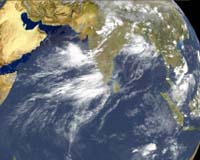| . |  |
. |
Dhaka (AFP) April 10, 2010 Bangladesh claimed sovereignty Saturday over a tiny island at the centre of a dispute between Dhaka and New Delhi, despite claims by Indian researchers that it has disappeared under rising sea levels. The uninhabited outcrop -- called New Moore island by India and South Talpatti by Bangladesh-- was 3.5 kilometres (about two miles) long and 3.0 kilometres wide before it was swallowed up by the Bay of Bengal. Indian scientists last month said satellite images had found no trace of the island as global warming and erosion appeared to have solved a point of contention between India and Bangladesh, which both claimed the island. But Dhaka's foreign secretary Mirajul Quayes said the island could appear again and Bangladesh still "has sovereignty over the territory as it is located to the east of the Radcliffe Line" that divides India and Bangladesh. The line, named after Sir Cyril Radcliffe, became the border between India and Pakistan after the partition of British India in 1947. Bangladesh was part of Pakistan at partition before becoming independent in 1971. Khorshed Alam, a senior foreign ministry official, said South Talpatti was never a full-fledged island as claimed by India. "It was a low tide elevation which could be seen only during low tide since 1980. It has always been submerged under water. But there is a strong chance that it would appear again like many other islands of the country," he said. In 1981, the Indian navy planted its national flag on the island, but no permanent settlement was established. The island, which is thought to have been created by a cyclone only about 40 years ago, sat in the Sundarbans mangrove delta in the mouth of the Hariabhanga River that divides India and Bangladesh. At its height, it was never more than two metres (about six feet) above sea level. Sugata Hazra, a professor of the School of Oceanographic Studies at Jadavpur University who has studied satellite images, said a larger island, Lohachara, disappeared in the Bay of Bengal in 1996. At least five other islands in the region are also threatened, he said. Bangladesh is one of the countries worst affected by climate change with some scientists predicting 20 million people will be displaced by 2050 because of rising sea levels.
Share This Article With Planet Earth
Related Links Water News - Science, Technology and Politics
 Australia neglecting Indian Ocean strategy
Australia neglecting Indian Ocean strategyCanberra, Australia, April 1, 2010 Australia has seriously neglected the strategic importance of the Indian Ocean region in favor of its Pacific Ocean interests, a policy think tank said. The region has 48 independent countries and several major extra-regional stakeholders - China, France, Japan, Russia, the European Union and the United States. Of all the countries Australia has the largest maritime jurisdiction ... read more |
|
| The content herein, unless otherwise known to be public domain, are Copyright 1995-2010 - SpaceDaily. AFP and UPI Wire Stories are copyright Agence France-Presse and United Press International. ESA Portal Reports are copyright European Space Agency. All NASA sourced material is public domain. Additional copyrights may apply in whole or part to other bona fide parties. Advertising does not imply endorsement,agreement or approval of any opinions, statements or information provided by SpaceDaily on any Web page published or hosted by SpaceDaily. Privacy Statement |